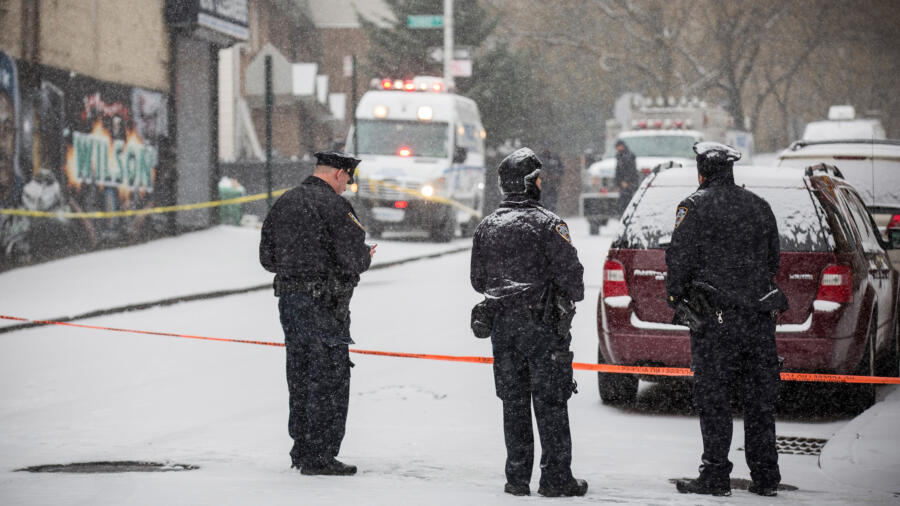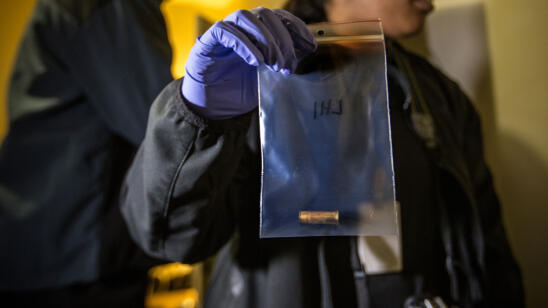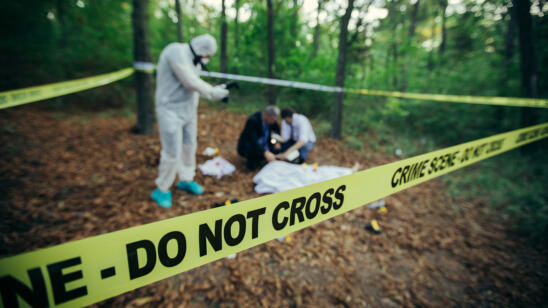Ken Martin, a 33-year veteran of the Massachusetts State Police, who retired as the commanding officer of the Crime Scene Services Division, has worked on countless crime scenes and “processed” hundreds of victims. In the second part of a three-part series (you can read the first part here) about the ins and outs of crime-scene investigation, we asked him to break down what happens once law-enforcement teams arrive and some of the challenges he’s faced in gathering evidence.
How do you define the size and scope of the crime scene?
You establish an outer perimeter first. For example, say you have a homicide at a single-family house. The homicide occurred inside the home. The first thing you want to do is gather all the information you have, because first responders have been there. This will give you some indication of what type of evidence you are looking for. The first responder may know if the victim was deceased in the house (having died there). They’ll set up what’s called the outer perimeter and include the whole house.
We do this because—and I’ve had it happen—someone was running out of house and dropped something. If there’s an indication that there was a car and tires, you’re going to want to look at that. You can never make the perimeter too big. You can always decrease it if necessary. Because, as you know and have probably seen on the news or on TV shows, everyone gets right up to the crime-scene barrier tape.
The inner perimeter would be the house proper, where only CSIs [crime-scene investigators] or sometimes prosecutors or investigating officers will go. Some district attorneys or prosecutors like to go in to see the scene, to have it in their mind.
Now, [the crime-scene investigator] goes into the scene and gathers as much information as he or she can. Usually, uniformed officers do a canvass of the area, and if a firearm is found in the trash around corner—which is not uncommon—you can dispatch someone there to process that. That becomes a ‘secondary scene.’ We deal with those while working on primary scene.
There are two schools of thought as to where the primary scene is. Is it where the victim is found or is it where he or she was killed? It is generally accepted that the primary scene is where victim is and anything else is a secondary scene.
What do the first teams on the scene need to be thinking about?
The primary responsibility of first responders is the care of victims. And that of law enforcement is to ensure that the premises are safe. They need to make sure the suspect is not hiding in the house. In many or most instances, crime-scene responders do have to go through crime scenes. I testify in court cases and sometimes people will bring up that the first responder contaminated the scene. But you have to take care of the injured, and safety is paramount. I tell the first responders: You’re no good to anyone if you’ve been shot or stabbed yourself. It is most important that you ensure the scene is safe.
When I teach at academies, I tell them that if there is a firearm on the floor and you know the suspect is nowhere to be found, then there is no need for you to pick it up. Leave it where it’s at because it may have some evidentiary value in the way it has been dropped. On the other hand, if there’s the possibility that there’s still a threat to you, I’d be the first to say ‘Do what you have to do! Pick it up [and] put it away.’ I just want to make sure we’re not investigating two homicides.
What else is important to know about going over a crime scene?
I’ve processed about 200 bodies overall. Many times, you’ll see it takes us a good two days to process a body, depending on the severity of the scene. I tell investigators it’s going to take me about eight hours to go through looking for hairs, fibers and fingernail scrapings. You have to be very meticulous. And it’s very important to document where that piece of evidence is located.
For example, if I find a pubic hair with a root, then we can DNA test it. I don’t put it in a bag without photographing it on-site (because you always photograph a piece of evidence prior to recovery). If it’s found inside the victim’s underwear and matches a DNA profile, it has more evidentiary value. It’s different evidence than if it was found on the sleeve.
What is the chain of evidence or chain of custody?
It’s two things: It is being able to account for every location that piece of evidence has been sitting in and, also, keeping track of everyone who has handled that piece of evidence from time of seizure to time of introduction in court.
That chain of custody is the important thing that all agencies try to ensure now—and when it comes up in court. That’s what they [the lawyers] look for. Right away, defense attorneys are looking for some loophole. If you as crime-scene investigator properly recover evidence, and it’s properly retained and examined, then there’s not much the defense can do. If they can’t get it thrown out because of some type of administrative continuity error, it becomes very difficult to get rid of.
Jurors certainly expect forensic evidence nowadays and they expect agencies to do a good job. One of the defense arguments we hear is that the state or investigative body didn’t do due diligence in totally processing at the scene. If they had, they would have gone on and recovered the evidence of the killer, who, of course, is not their client.
What are some common challenges you’ve come across in evidence gathering?
For example, in court an argument I might get is: ‘How come you didn’t find fingerprints at the scene?’ Jurors have the misconception that as soon as I touch something, my fingerprints are there. Someone coming into scene would have had to touch something [and leave fingerprints]. Hypothetically, maybe someone had their hands in their pockets and came in and choked the victim and walked out of an open door. Guess what you’re not going to find? Prints.
That’s why it’s important to have some hypotheses as to what went on, because it gives us an idea of where to look. Say the attacker was chased around a kitchen counter, and they happen to grab underneath it. We could find those prints.
It’s worth noting that in winter, you may not be perspiring as much or you are washing and drying your hands. That’s drying off the secretions, oils, and lipids, so you won’t get that evidence. Also, there are people that don’t have very good friction-ridge skin [who are] extremely difficult to print, such as my wife. But she’s managed to resist a life of crime.
Is it true that bare footprints are like fingerprints?
Yes, footprints are unique and identifiable, just like fingerprints. This could be useful if I had a home invasion at night or a sexual assault. It’s not improbable that I could get footprints that belong to the victim. I can use the footprints to identify a suspect.
I had a case where a boyfriend and girlfriend in an apartment building killed a neighbor. Then they ended up going in and out of the victim’s apartment in their bare feet over the course of a couple of days stealing items. We were literally able to develop footprints of both of them going into the apartment, being in there barefoot, and tie them to the apartment.
What have you been surprised by?
You’ve heard this before: Every scene is different…given the circumstances that you’re in. As a crime-scene investigator, you have to consider that. I had a case, a shooting, [where] a mother, her father and daughter were all shot with the same firearm and ammunition. All the conditions should be pretty much the same. When we went to the scene, the daughter, who was an adolescent, had a tremendous amount of damage to the head area. It appeared to be inconsistent with the damage to the mother and grandfather.
Ultimately, when we went to autopsy, it turned out she had a congenitally thin skull which allowed that energy to be more dissipated through directed spatter. We actually had a piece of skull some 15 feet down the hall that had hit the wall. Before the autopsy finding, we were wondering if there were possibly two weapons because of the severity of her injuries. The condition wasn’t impeding her health and she probably didn’t know about it, but it allowed for massive destruction at the scene.
Read Part 1 of the interview: Why It’s OK to Leave Dead Bodies in the Woods, and Other Strategies for Not Messing Up A Crime Scene


